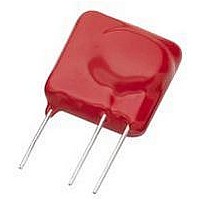TMOV25SP385M Littelfuse Inc, TMOV25SP385M Datasheet - Page 46

TMOV25SP385M
Manufacturer Part Number
TMOV25SP385M
Description
TMOV VARISTOR PB FREE 25S
Manufacturer
Littelfuse Inc
Series
iTMOV®r
Specifications of TMOV25SP385M
Varistor Voltage
682V
Current-surge
20kA
Number Of Circuits
1
Maximum Ac Volts
385VAC
Energy
430J
Package / Case
Disc 25mm 3-Lead
Suppressor Type
Varistor
Peak Surge Current @ 8/20µs
20000A
Varistor Case
25mm DISC
Clamping Voltage Vc Max
1010V
Peak Energy (10/1000us)
430J
Voltage Rating Vdc
682V
Voltage Rating Vac
385V
Lead Free Status / RoHS Status
Lead free / RoHS Compliant
Maximum Dc Volts
-
Lead Free Status / Rohs Status
Lead free / RoHS Compliant
- Current page: 46 of 212
- Download datasheet (7Mb)
ML Varistor Series
Lead (Pb) Soldering Recommendations
The principal techniques used for the soldering of
components in surface mount technology are IR Re-flow
and Wave soldering. Typical profiles are shown on the right.
The recommended solder for the ML suppressor is
a 62/36/2 (Sn/Pb/Ag), 60/40 (Sn/Pb) or 63/37 (Sn/Pb).
Littelfuse also recommends an RMA solder flux.
Wave soldering is the most strenuous of the processes.
To avoid the possibility of generating stresses due to
thermal shock, a preheat stage in the soldering process
is recommended, and the peak temperature of the solder
process should be rigidly controlled.
When using a reflow process, care should be taken to
ensure that the ML chip is not subjected to a thermal
gradient steeper than 4 degrees per second; the ideal
gradient being 2 degrees per second. During the soldering
process, preheating to within 100 degrees of the solder's
peak temperature is essential to minimize thermal shock.
Once the soldering process has been completed, it is
still necessary to ensure that any further thermal shocks
are avoided. One possible cause of thermal shock is hot
printed circuit boards being removed from the solder
process and subjected to cleaning solvents at room
temperature. The boards must be allowed to cool gradually
to less than 50º C before cleaning.
Lead–free (Pb-free) Soldering Recommendations
Littelfuse offers the Nickel Barrier Termination option (see
"N" suffix in Part Numbering System for ordering) for the
optimum Lead–free solder performance, consisting of a
Matte Tin outer surface plated on Nickel underlayer, plated
on Silver base metal.
The preferred solder is 96.5/3.0/0.5 (SnAgCu) with an RMA
flux, but there is a wide selection of pastes and fluxes
available with which the Nickel Barrier parts should be
compatible.
The reflow profile must be constrained by the maximums
in the Lead–free Reflow Profile. For Lead–free wave
soldering, the Wave Solder Profile still applies.
Note: the Lead–free paste, flux and profile were used for
evaluation purposes by Littelfuse, based upon industry
standards and practices. There are multiple choices of all
three available, it is advised that the customer explores the
optimum combination for their process as processes vary
considerably from site to site.
Surface Mount Multilayer Varistors (MLVs) > ML Series
Revision: November 5, 2009
Varistor Products
42
Figure 14
Figure 15
Figure 16
Reflow Solder Profile
Wave Solder Profile
Lead–free Re-flow Solder Profile
300
250
200
100
250
200
150
100
150
300
250
200
150
100
50
50
50
0
0
0
0.0
0
0
0.5
0.5
MAXIMUM TEMPERATURE 260˚C,
TIME WITHIN 5˚C OF PEAK
20 SECONDS MAXIMUM
1.0
Please refer to www.littelfuse.com/series/ML.html for current information.
PREHEAT ZONE
PREHEAT ZONE
1.0
1.0
PREHEAT DWELL
FIRST PREHEAT
2.0
MAXIMUM TEMPERATURE
1.5
1.5
TIME (MINUTES)
TIME (MINUTES)
MAXIMUM WAVE 260°C
TIME (MINUTES)
RAMP RATE
<3˚C/s
3.0
2.0
Specifications are subject to change without notice.
230°C
2.0
SECOND PREHEAT
RAMP RATE
<2°C/s
2.5
4.0
2.5
ABOVE 183°C
SECONDS
3.0
40-80
5.0
60 - 150 SEC
3.0
> 217˚C
3.5
6.0
3.5
©2009 Littelfuse, Inc.
4.0
4.0
4.5
7.0
Related parts for TMOV25SP385M
Image
Part Number
Description
Manufacturer
Datasheet
Request
R

Part Number:
Description:
FUSEHOLDER 20A MINI INLINE CRIMP
Manufacturer:
Littelfuse Inc
Datasheet:

Part Number:
Description:
FUSEHOLDER BODY ATO INLINE PNLMT
Manufacturer:
Littelfuse Inc
Datasheet:

Part Number:
Description:
FUSE 2A 63V FAST 1206
Manufacturer:
Littelfuse Inc
Datasheet:

Part Number:
Description:
FUSE 1.25A 63V FAST 1206
Manufacturer:
Littelfuse Inc
Datasheet:

Part Number:
Description:
FUSE .250A 125V FAST 1206
Manufacturer:
Littelfuse Inc
Datasheet:

Part Number:
Description:
FUSE 4A 32V FAST 1206
Manufacturer:
Littelfuse Inc
Datasheet:

Part Number:
Description:
FUSE 1.75A 63V FAST 1206
Manufacturer:
Littelfuse Inc
Datasheet:

Part Number:
Description:
FUSE 1A 32V FST 0603 LEADFREE TR
Manufacturer:
Littelfuse Inc
Datasheet:

Part Number:
Description:
FUSE 1A 32V FAST SLIM 0402
Manufacturer:
Littelfuse Inc
Datasheet:

Part Number:
Description:
FUSE 2A 125V FAST NANO2 SMD
Manufacturer:
Littelfuse Inc
Datasheet:

Part Number:
Description:
FUSE .250A 125V FAST NANO2 SMD
Manufacturer:
Littelfuse Inc
Datasheet:

Part Number:
Description:
FUSE .500A 125V FAST NANO2 SMD
Manufacturer:
Littelfuse Inc
Datasheet:

Part Number:
Description:
FUSE 1.5A 125V FAST NANO2 SMD
Manufacturer:
Littelfuse Inc
Datasheet:

Part Number:
Description:
FUSE 4A 125V FAST NANO2 SMD
Manufacturer:
Littelfuse Inc
Datasheet:

Part Number:
Description:
FUSE 1A 125V FAST NANO2 SMD
Manufacturer:
Littelfuse Inc
Datasheet:










